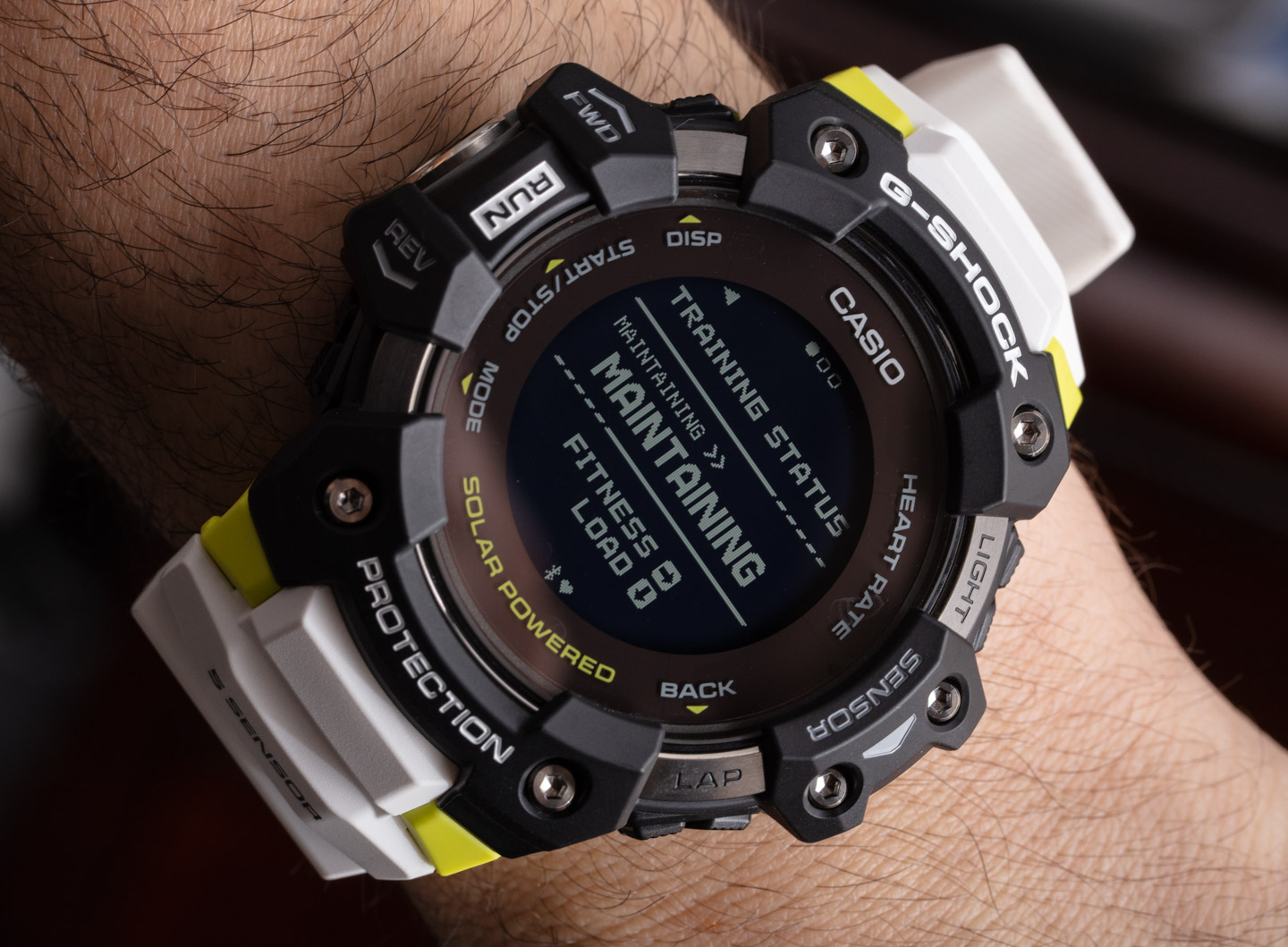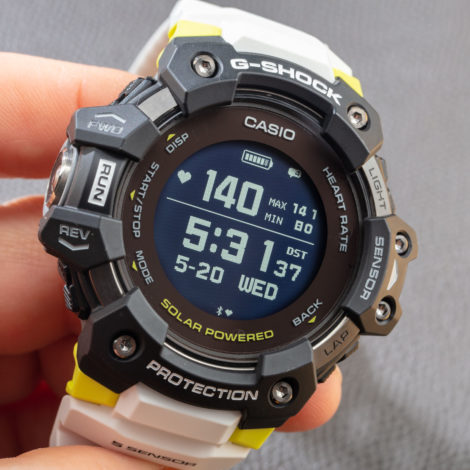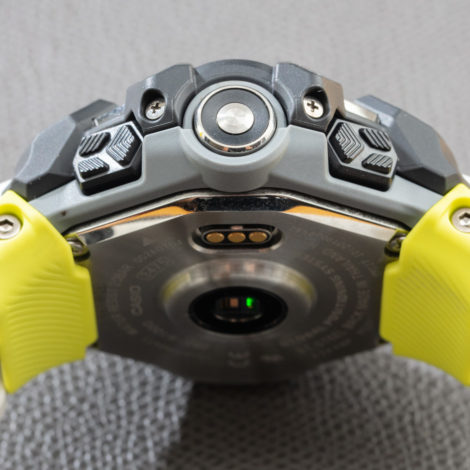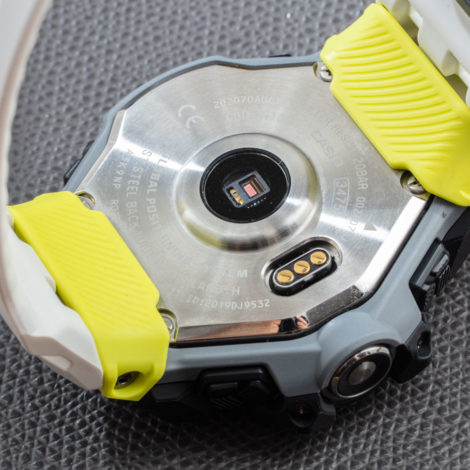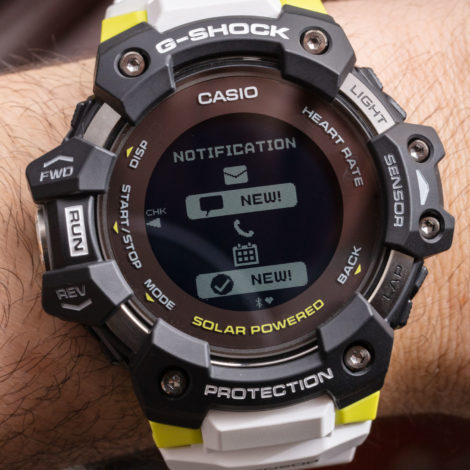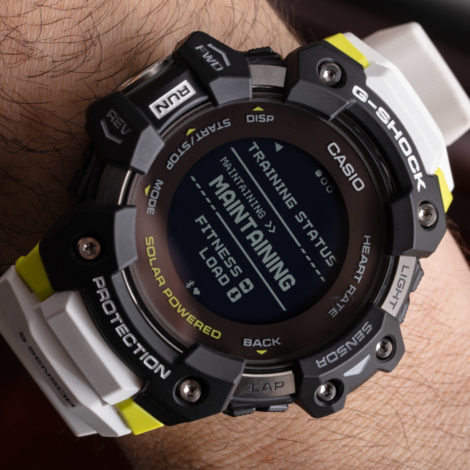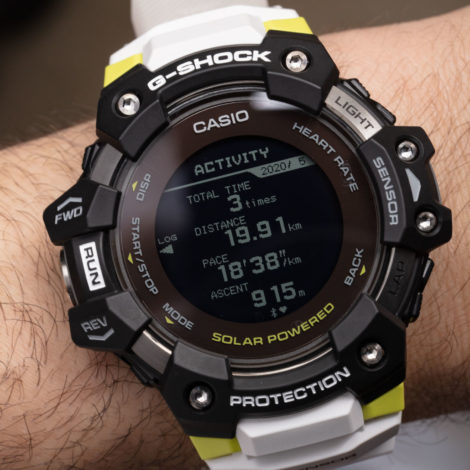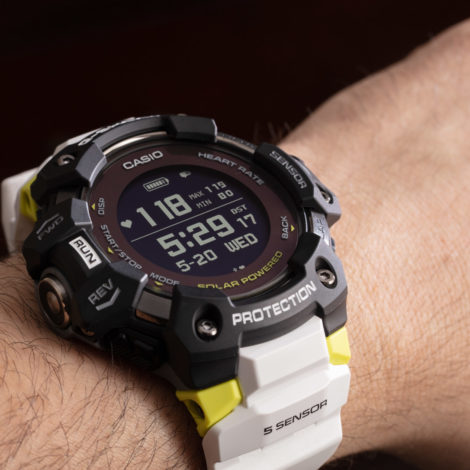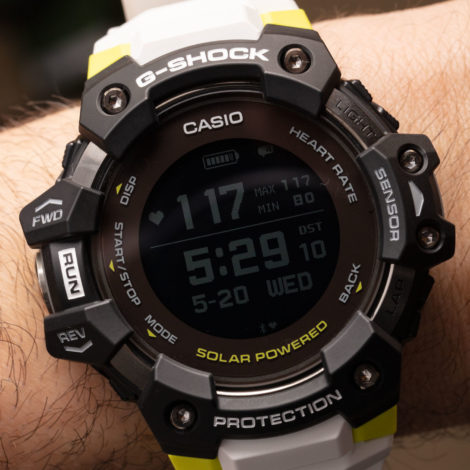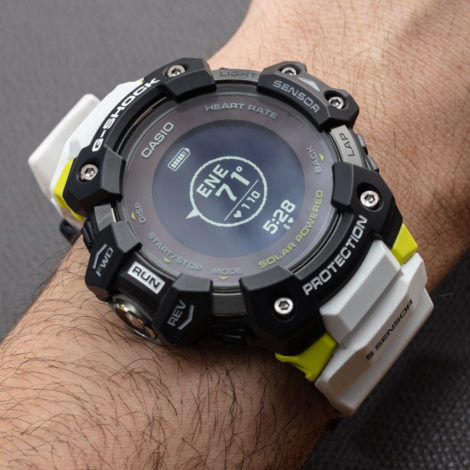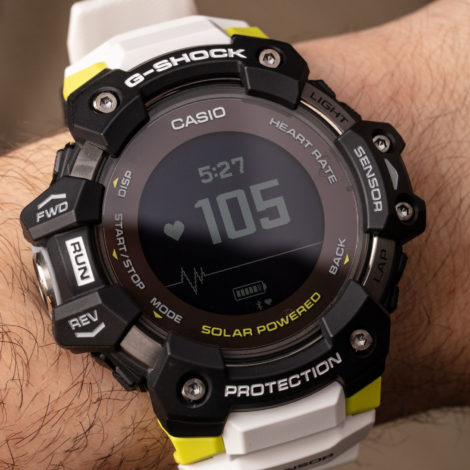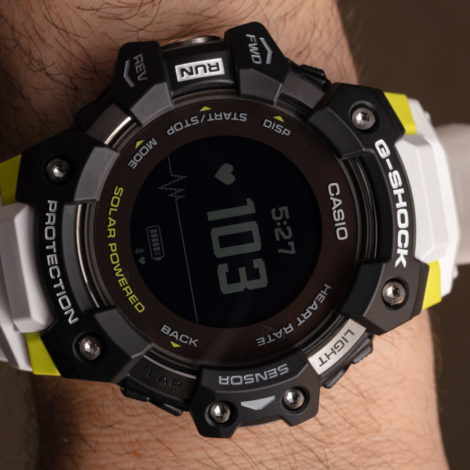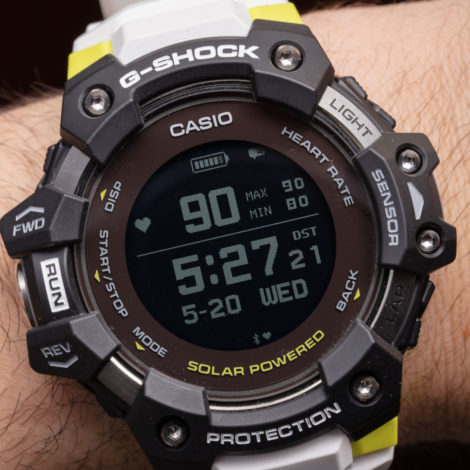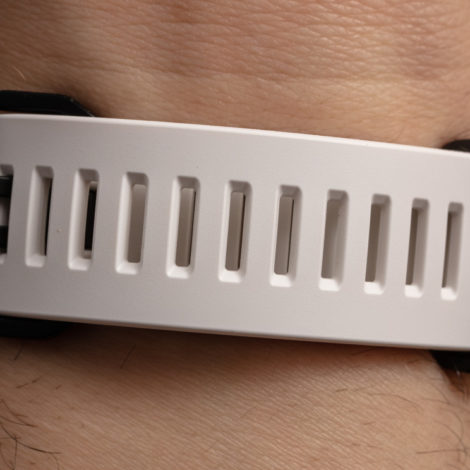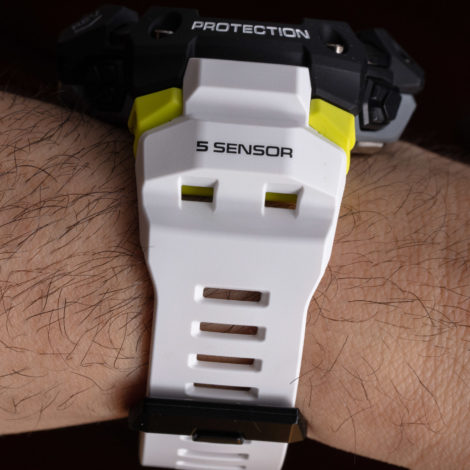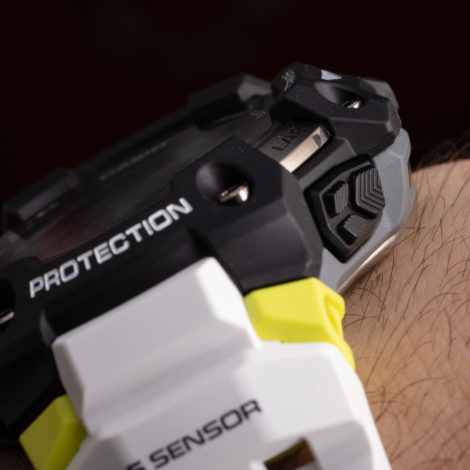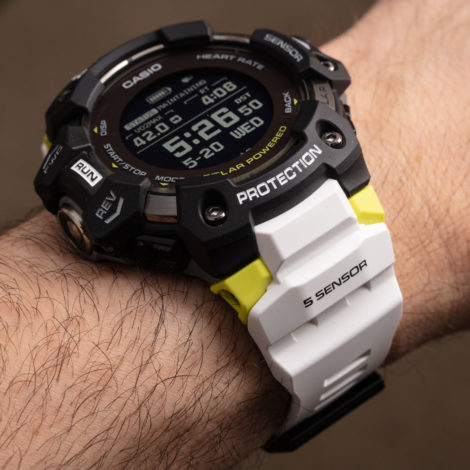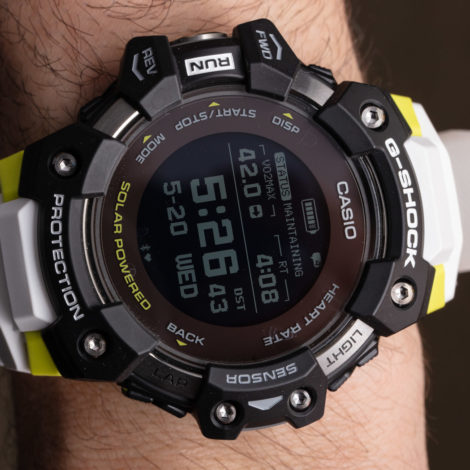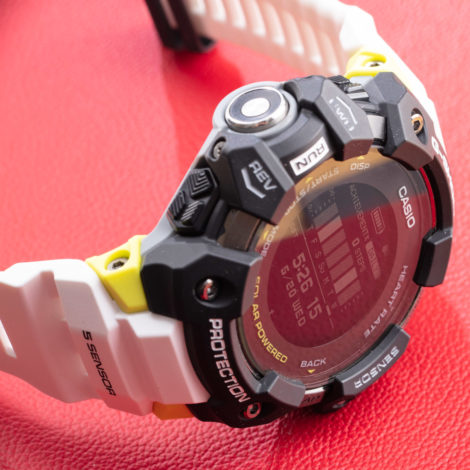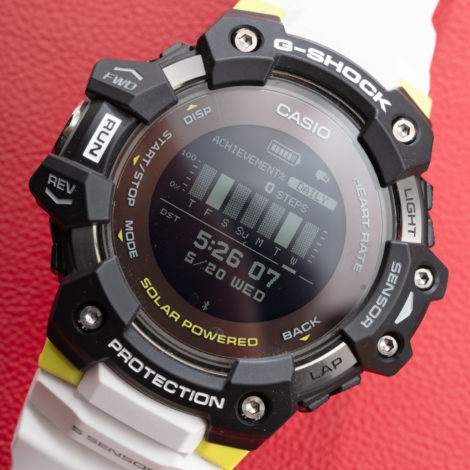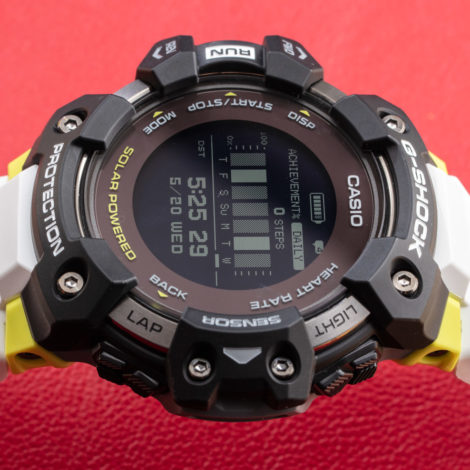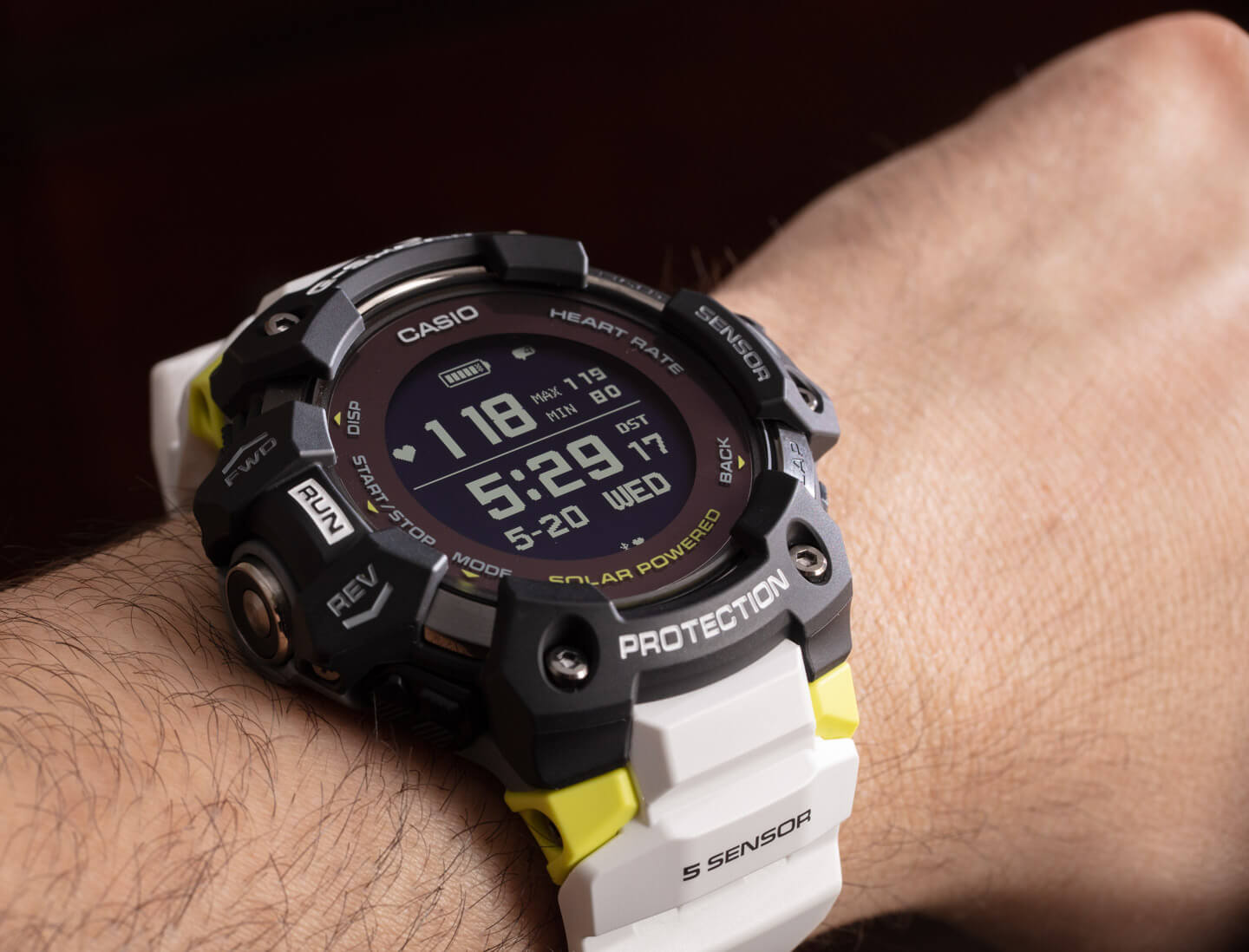 This year in 2020 Japan’s Casio introduced an even clearer glimpse of the future of G-Shock. The world-famous “bulletproof” collection of highly durable G-Shock timepieces is more than 35-years-old, and Casio continues to produce both fashionable legacy models and technologically sophisticated modern G-Shock products with mainstream appeal for consumers beyond mere timepiece enthusiasts and collectors. The G-Shock Move is just such a product, and today, I am reviewing the Casio G-Shock Move GBD-H1000 (specifically, the black, white, and neon green reference GBDH1000-1A7). Don’t miss our quick-start guide on this reference if you’d just like to learn about its core features and how to log your first workout.
This year in 2020 Japan’s Casio introduced an even clearer glimpse of the future of G-Shock. The world-famous “bulletproof” collection of highly durable G-Shock timepieces is more than 35-years-old, and Casio continues to produce both fashionable legacy models and technologically sophisticated modern G-Shock products with mainstream appeal for consumers beyond mere timepiece enthusiasts and collectors. The G-Shock Move is just such a product, and today, I am reviewing the Casio G-Shock Move GBD-H1000 (specifically, the black, white, and neon green reference GBDH1000-1A7). Don’t miss our quick-start guide on this reference if you’d just like to learn about its core features and how to log your first workout.
Casio G-Shock evolution isn’t a linear progression of products that directly improve upon one another but is more like an evolutionary tree with arms that branch into different directions representing the various ways Casio engineers have played with keeping G-Shock watches both innovative and relevant. One direction was to take all the durability and functionality of G-Shock watches and to render them in entirely analog (non-digital) form with products that have their apex in the MR-G collection. Another direction was to incorporate Bluetooth functionality into mainstream timepiece products as a simple way to update the time as people travel. Casio has even invested in smartwatches ranging from the Google Wear-powered WSD-F30 (the latest generation Casio smartwatch at the time of writing), as well as hybrid approaches that combine smartwatch functionality with more traditional G-Shock functionality. The G-Shock Move GBD-H1000 is just such a hybrid product, and I personally think it represents the future of Casio G-Shock watches better than pretty much anything else Casio has released lately.
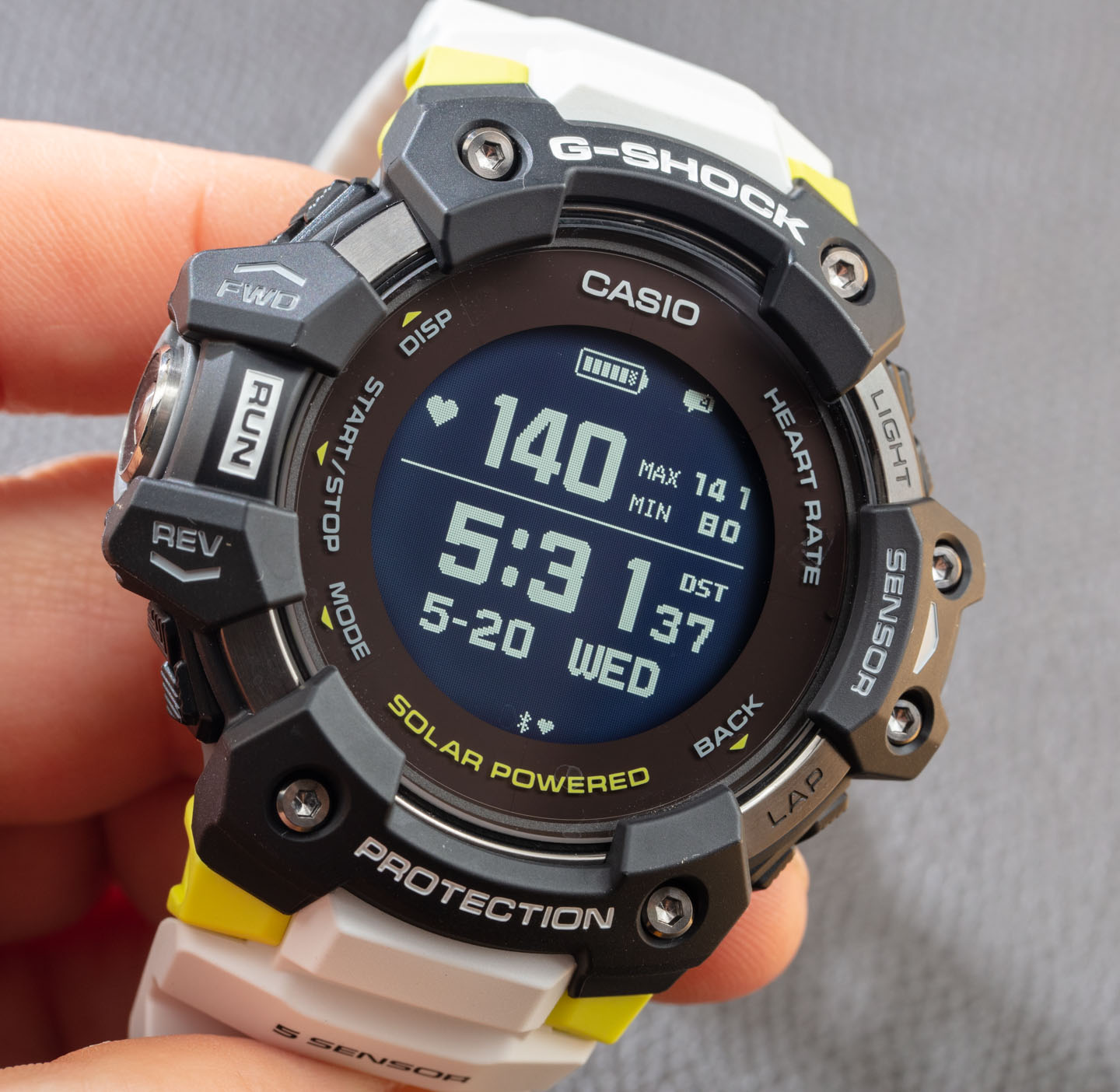
G-Shock Hybrid Smartwatch Evolution
The GBD-H100’s direct predecessor was the Casio G-Shock Rangeman GPR-B1000 (aBlogtoWatch review here) that introduced the new MIP LCD display, dual USB/solar charging, and the new-generation operating system. The GPR-B1000 is a dive-style watch and is also both larger and twice as expensive as the newer GBD-H1000. This latest generation G-Shock product price point is likely a strategic decision, as Casio wishes to aggressively capture more of the smartwatch and activity tracker market. Given what you get, the price actually feels like a bargain when looking at the competition.
The G-Shock Move is also the brand’s first “Five Sensor” watch with the addition of a dedicated heart-rate monitor. The product actually has more than five sensors, but given the traditional way these are counted, those five sensors are a compass, altimeter/barometer, thermometer, step counter, and heart-rate monitor. Don’t forget that the Casio module inside the GBD-H1000 has features GPS signal and Bluetooth connectivity.
The reason I refer to the G-Shock Move as a “hybrid smartwatch” is because as a “connected” timepiece that does offer notifications and Bluetooth connectivity, it certainly does more smart things than a traditional timepiece. That said, it doesn’t offer a more contemporary smartwatch experience with apps and bi-directional watch/phone communication like an Apple Watch or device running Google Wear.
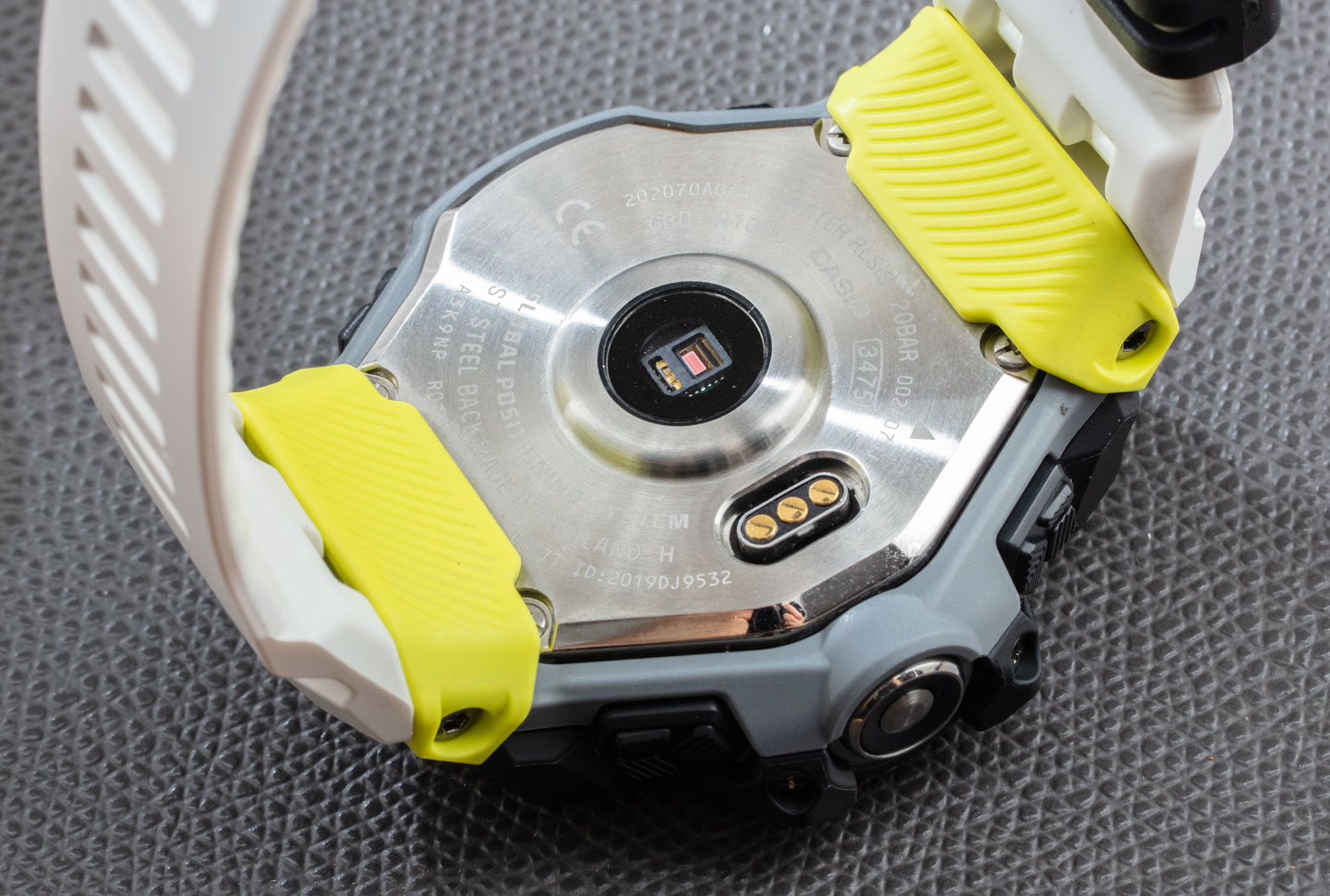 Instead, Casio developed its own operating system, which seems to emphasize focused functionality and efficiency. This is probably to prioritize battery life and overall reliability. Casio engineers have lots of experience creating calculators that use very low power. That is, basically, what most Casio digital watches, in effect, are. Features such as a heart-rate monitor and Bluetooth connectivity are things modern consumers want but that are hungry when it comes to battery life. Casio knows it can’t compete in all areas of the smartwatch and activity tracker market, but the brand has correctly surmised that they can have an edge when it comes to power-efficient devices.
Instead, Casio developed its own operating system, which seems to emphasize focused functionality and efficiency. This is probably to prioritize battery life and overall reliability. Casio engineers have lots of experience creating calculators that use very low power. That is, basically, what most Casio digital watches, in effect, are. Features such as a heart-rate monitor and Bluetooth connectivity are things modern consumers want but that are hungry when it comes to battery life. Casio knows it can’t compete in all areas of the smartwatch and activity tracker market, but the brand has correctly surmised that they can have an edge when it comes to power-efficient devices.
Accordingly, one of the most common complaints consumers have about smartwatches and activity trackers, in general, is the need to regularly charge them. The GBD-H1000 has both a passive solar charging system (the photovoltaic cell is actually a ring around the screen) and can be charged with a magnetic USB-based cable. Casio’s selling point is that, for the most part, you can wear and use the G-Shock Move like any other G-Shock timepiece without having to regularly charge it as you might a smartwatch. That said, if you are regularly using power-intensive features such as GPS tracking, the light-power system won’t be able to keep up with the battery drain. You can top up the battery as needed when relying on the GBD-H1000 for repeated, long-interval tracking purposes.
Casio will continue to improve upon the core features of the G-Shock Move, as such devices are always moving targets when it comes to adding new elements, improving hardware, and refining software. I truly believe that this new operating system represents the future of what most G-Shock watches will be like. The new screens are vastly more legible than standard LCD screens, the operating system is infinitely deeper and more engaging, and the added features such as a heart-rate monitor could easily find their way into an increasing percentage of the wristwatches Casio produces.
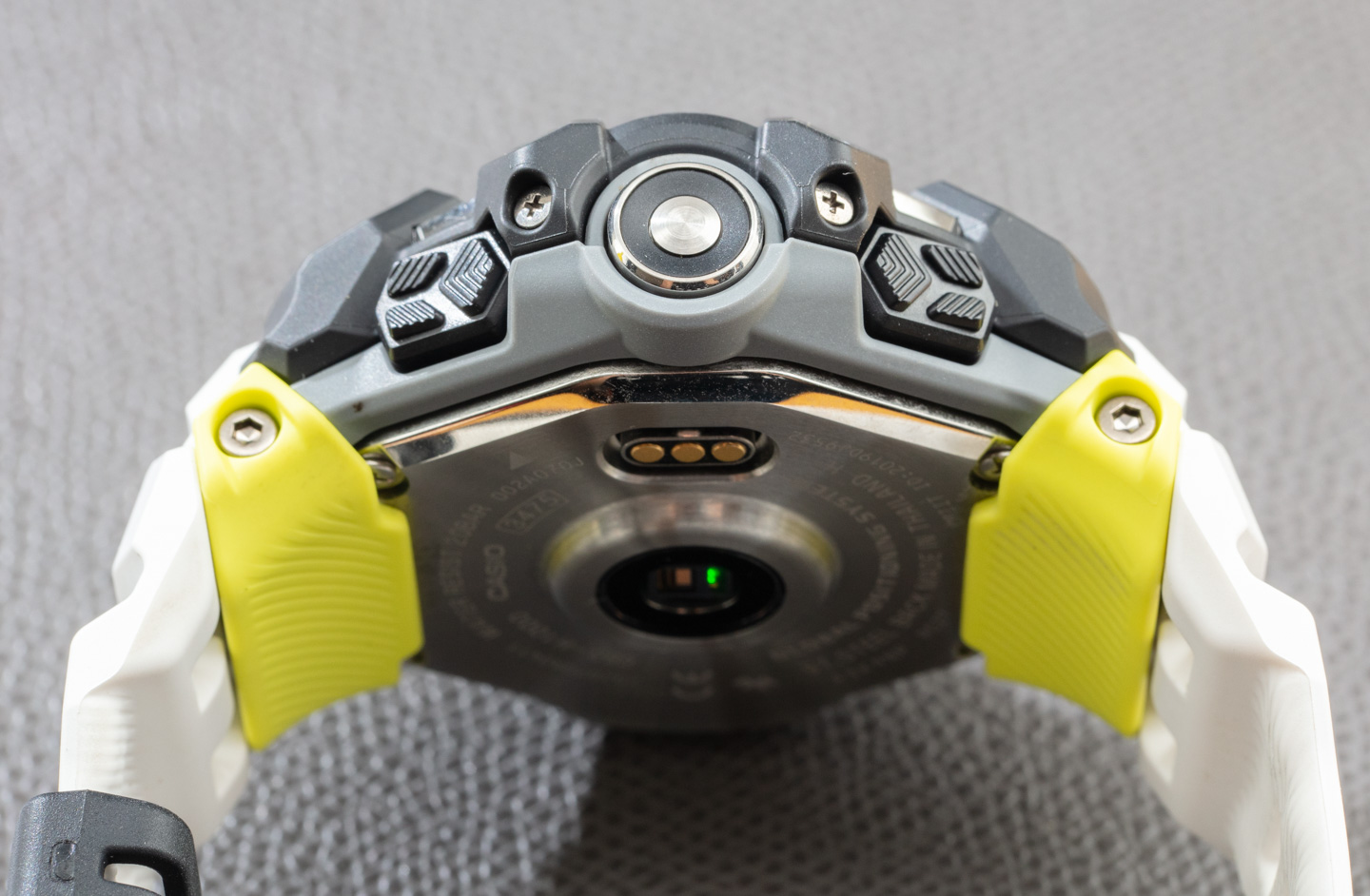
G-Shock Durability & Design
Even though the GBD-H1000 is now in the “G-Shock Move” family, I still consider it as a spiritual successor to the Rangeman family when a design perspective. The case is smaller and more wearable than the last generation Rangeman it replaces, but the GBD-H1000 is still a larger timepiece at 55mm-wide, 63mm from lug-to-lug, and 20.4mm-thick. The resin and steel case (water-resistant to 200 meters) is solidly made but weighs just 101 grams. Over the screen is a mineral crystal, which is protected by the steep bezel structure.
As with all G-Shock watches, you can easily throw the GBD-H1000 around and not worry about it. This is increasingly true of many competitive smartwatches out there, but I really don’t think most other timepieces out there can survive the abuse a G-Shock can, and still look good afterward.
Not everyone is a fan of the GBDH1000-1A7’s black, white, and neon green/yellow color scheme. It looks like it was designed to go with trendy running shoes, but otherwise, it is hard to fashionably match the timepiece with your daily wardrobe. Other colors will be available in the future, but right now Casio also makes the G-Shock Move GBDH1000-1 that is in all black resin for a slightly more conservative look.
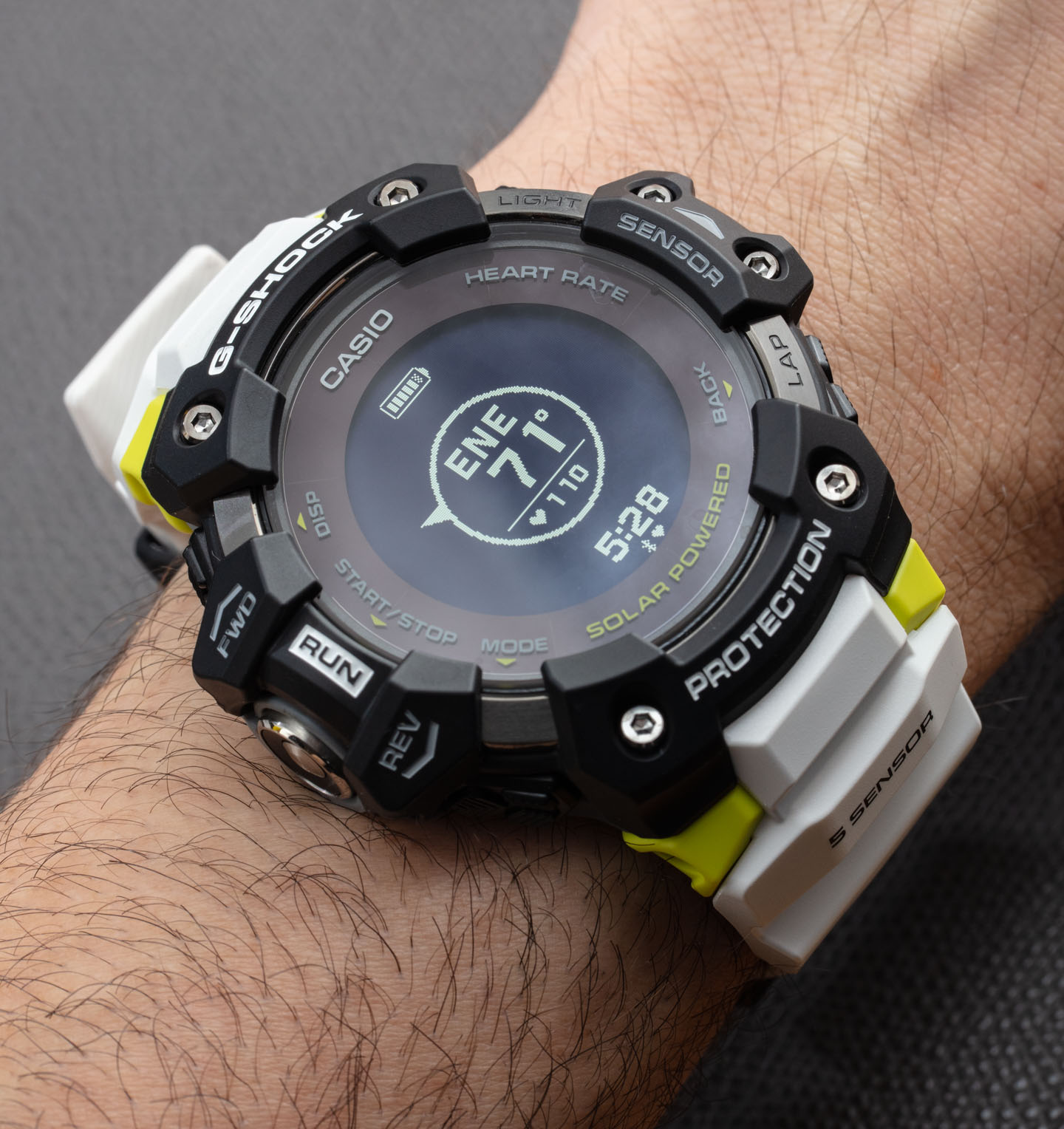
Compared to the Rangeman GPR-B1000, the GBD-H1000 has its pushers flipped, but otherwise, the case still has five buttons on it, and no “scroll wheel” like the Rangeman. Despite a relatively simple learning curve to understand how to use the new G-Shock operating system, I still feel that Casio has a ways to go in matching other modern smartwatches when it comes to intuitive user interface and input design. A scroll wheel or some type of directional arrow system would be a great inclusion — as knowing what button to press requires study and depends on the screen you are currently looking at.
The G-Shock move also has among the better attaching magnetic charging cables I’ve seen. They replaced the “claw dock” of the Rangeman, and while it takes a bit of finagling to make sure the cable is seated correctly, it remains securely attached to the caseback while charging. Having said that, I found myself only using the charger occasionally after heavy GPS usage. This is where I discuss my biggest compliment to the Casio team — finally a modern Bluetooth-connected activity tracker that I don’t need to worry about putting on the charger each day.
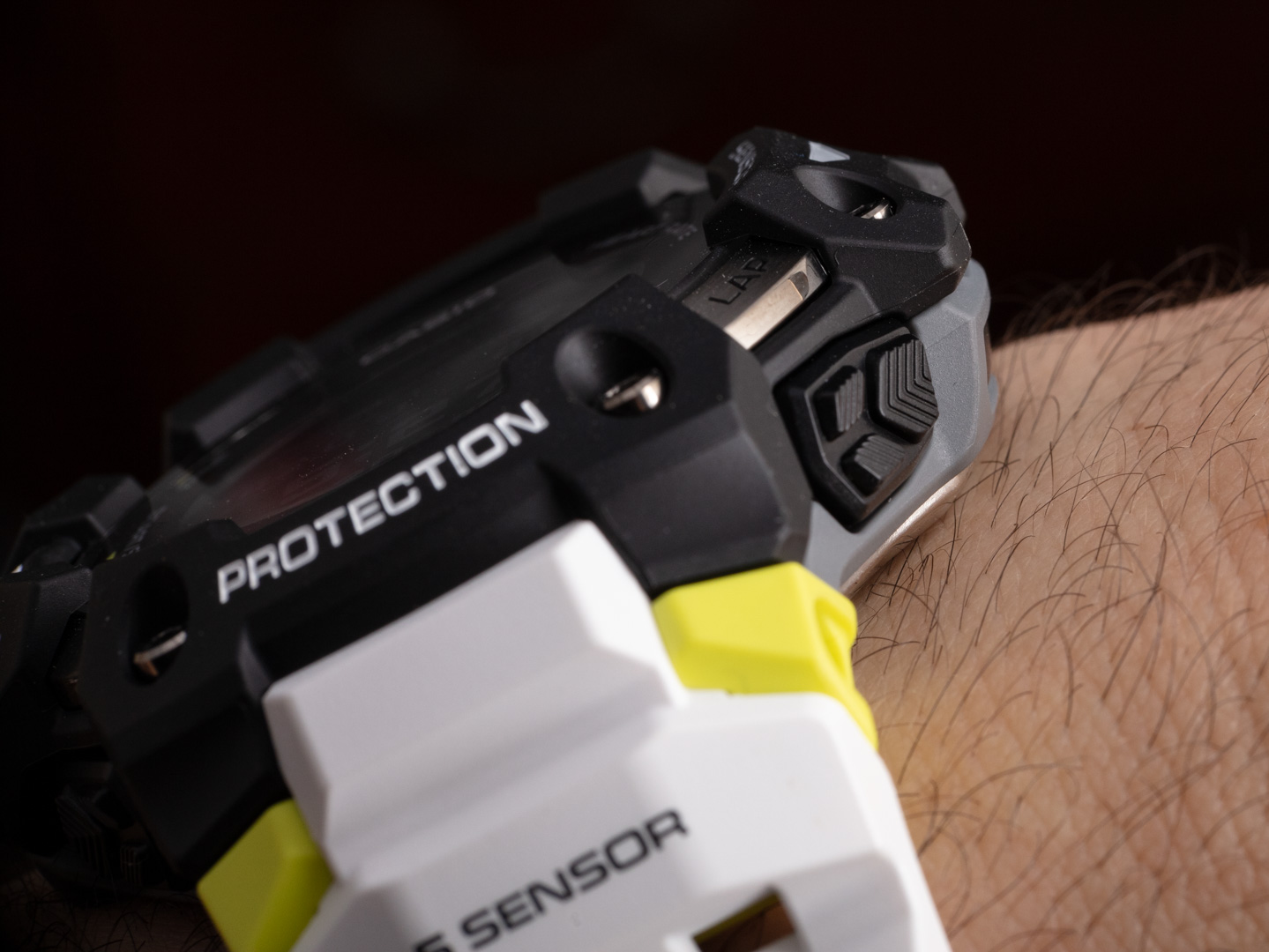
Mind you, I was charging the watch, but by putting it near a window so that light can hit the screen. It would be silly to suggest that a device like this doesn’t need to be charged — it is too power-hungry outside of its disconnected (from GPS/Bluetooth) power-saving mode to run on the internal battery alone for too long. It is more accurate to say that I kept the watch charged by using solar power as opposed to USB power. So, assuming you can expose your GBD-H1000 timepiece to enough sunlight each day, I think you should be able to use GPS tracking a few hours a week and probably avoid using the USB charger unless you are using tracking heavily.
Where I would like to see more design attention is the digital displays themselves. Sure, Casio’s engineers are still getting accustomed to a new system, but the displays are pretty basic-looking and lack the flair of, say, the case design. Casio is still new to creating modern-looking and attractive software user interface screens, but before long I’d like to see a bit more sexiness or at least additional display options when it comes to the aesthetic experience of reading the information on the GBD-H1000 and the products that will follow it.
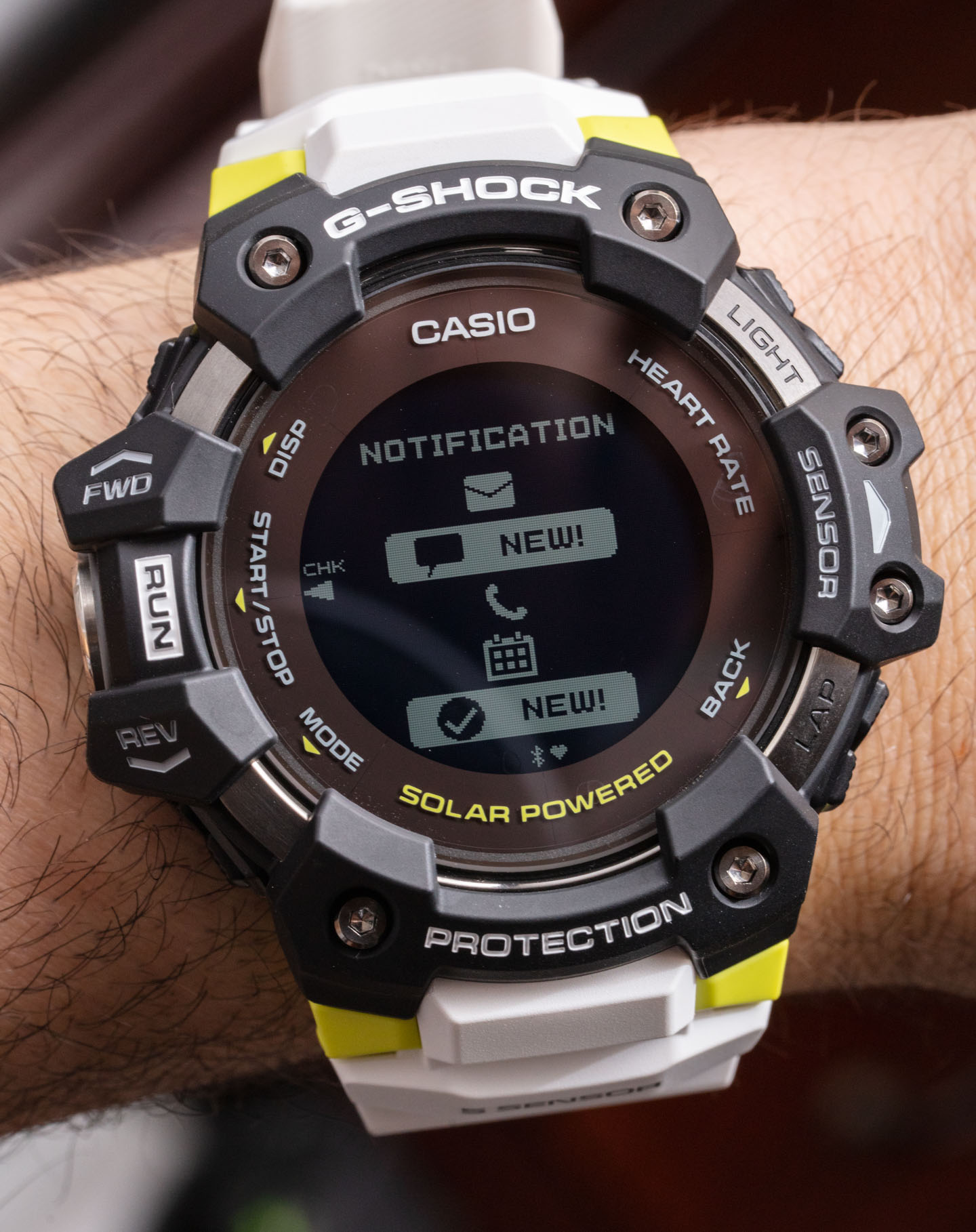
G-Shock Move App & Smartwatch Features
While most of the existing Bluetooth-enabled Casio watches use its G-Shock Connect app, the GBD-H1000 is the first or among the first Casio watches to use the new G-Shock Move app. This app allows you to adjust various settings on the watch, and also receives activity data from the watch allowing you to view more information about your workouts/adventures as well as helps keep you on point with your fitness goals.
I’ve used a good number of smartwatch apps so far and tend to find that each of them has small quirks. A common one is having to sometimes restart the app or manually initiate a pairing to get your watch and smartphone to speak to each other. Only the Apple Watch with its totally proprietary software ecosystem seems to avoid this. It isn’t that big a deal, but I hope in the future Bluetooth-connected watches and their related smartphone application software connect more seamlessly and reliably in the background.
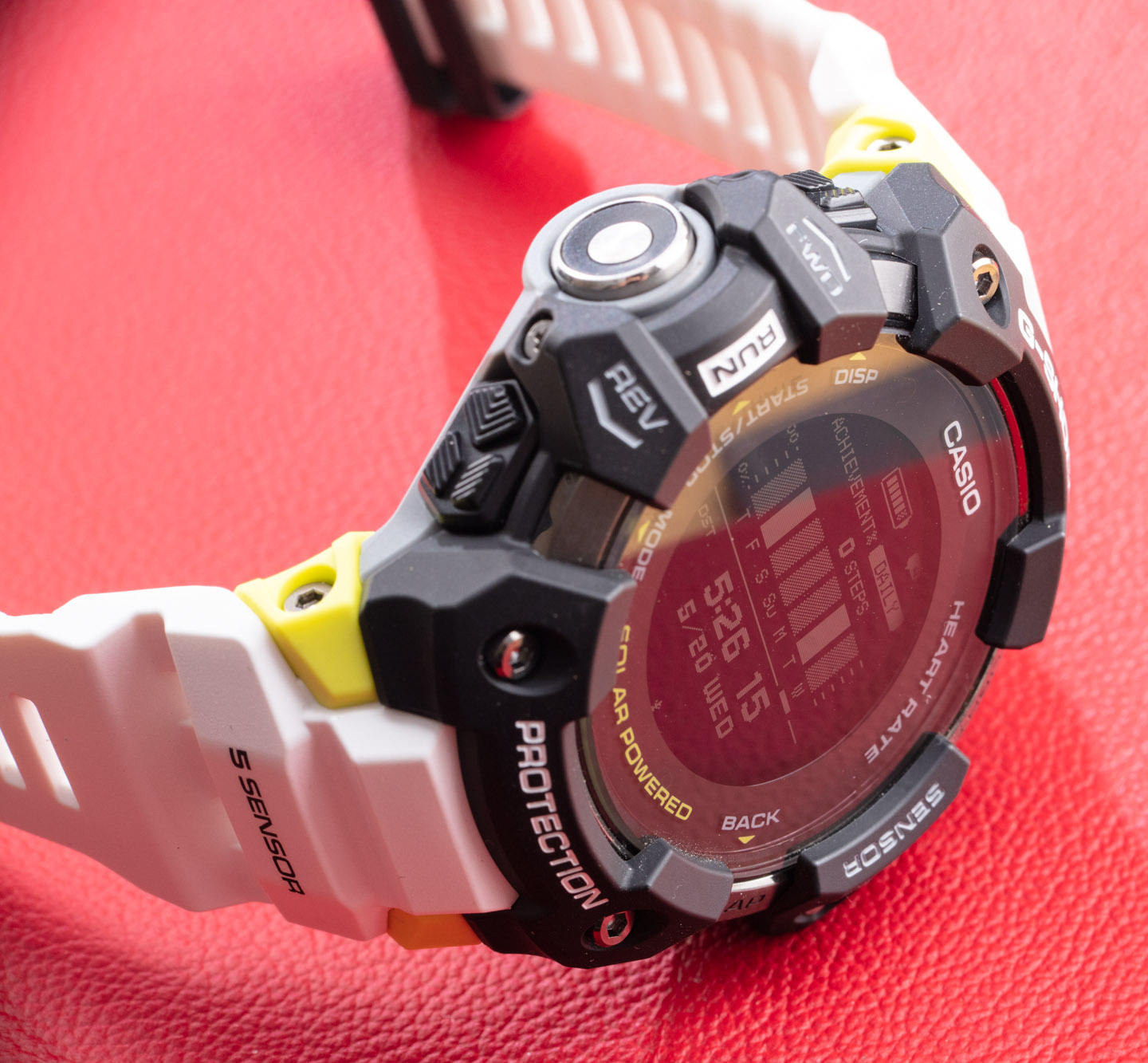
There is a lot you can do and view in the G-Shock Move app that isn’t really natively available on the watch, or is simply more convenient on the phone. I found, for example, that viewing the details of my workout wasn’t as simple on the watch screen itself as compared with the app. The app is also appreciably snappier than the G-Shock Move watch itself in certain regards. The timepiece’s operating system doesn’t normally lag, but it does take some time if it is updating something related to memory (such as saving or deleting a workout). This is all likely related to Casio’s desire to keep the system lean and not use too much power in order to preserve battery life. As such, pretty much all smartwatches and activity trackers today have functionality based on the premise of balancing battery life and performance.
While you can get basic smartphone notifications on your GBD-H1000 screen, I prefer to turn this feature off since I find it a bit distracting (because it isn’t that straightforward a process). I like to think of the smartphone connectivity to be an accessory to an otherwise independent timepiece device. Some smartwatches, such as the Apple Watch, aren’t really meant to live too long without being near their host phone device. The GBD-H1000 has features that get a big boost by working with a smartphone, but in reality, this is a product that can still be used entirely independently of a smartphone. Even things like auto-updating of the time can be done directly via a GPS signal.

What Its Like Using The G-Shock Move GBD-H1000 As Exercise Activity Tracker
Now let’s talk about getting sweaty with the G-Shock Move GBD-H1000. All this theoretical talk about activity tracking is just a prelude to experiencing the timepiece as an exercise companion for me. My preferred activity to test out sport smartwatches is hiking. It also helps that I do the same activity with different products so that I can evaluate how different products compare with each other. I will say right now that there is no single best timepiece I’ve used for tracking my hikes and bike rides. There are things Apple, Garmin, and Casio each do best, and other areas in which they may be beaten by the competition.
To a degree, this is about design, but more accurately I’d say that each activity tracking watchmaker chooses a different mixture of priorities for their products. For example, some watches will offer you more functionality but far less battery life. The longer you need to go between battery charges, the less the device will do for you. As I said before, Casio’s focus with its activity trackers right now is both ultra-durability and long-lasting battery life.
The MIP LCD screen is actually brighter in the sunlight and one of the most legible digital displays I’ve ever experienced on such a watch. It reflects light similar to many Garmin screens but in an even more effective way (though the Casio screen is monochromatic, whereas Garmin has a full-color display). So, high marks overall to Casio for these new types of screens.
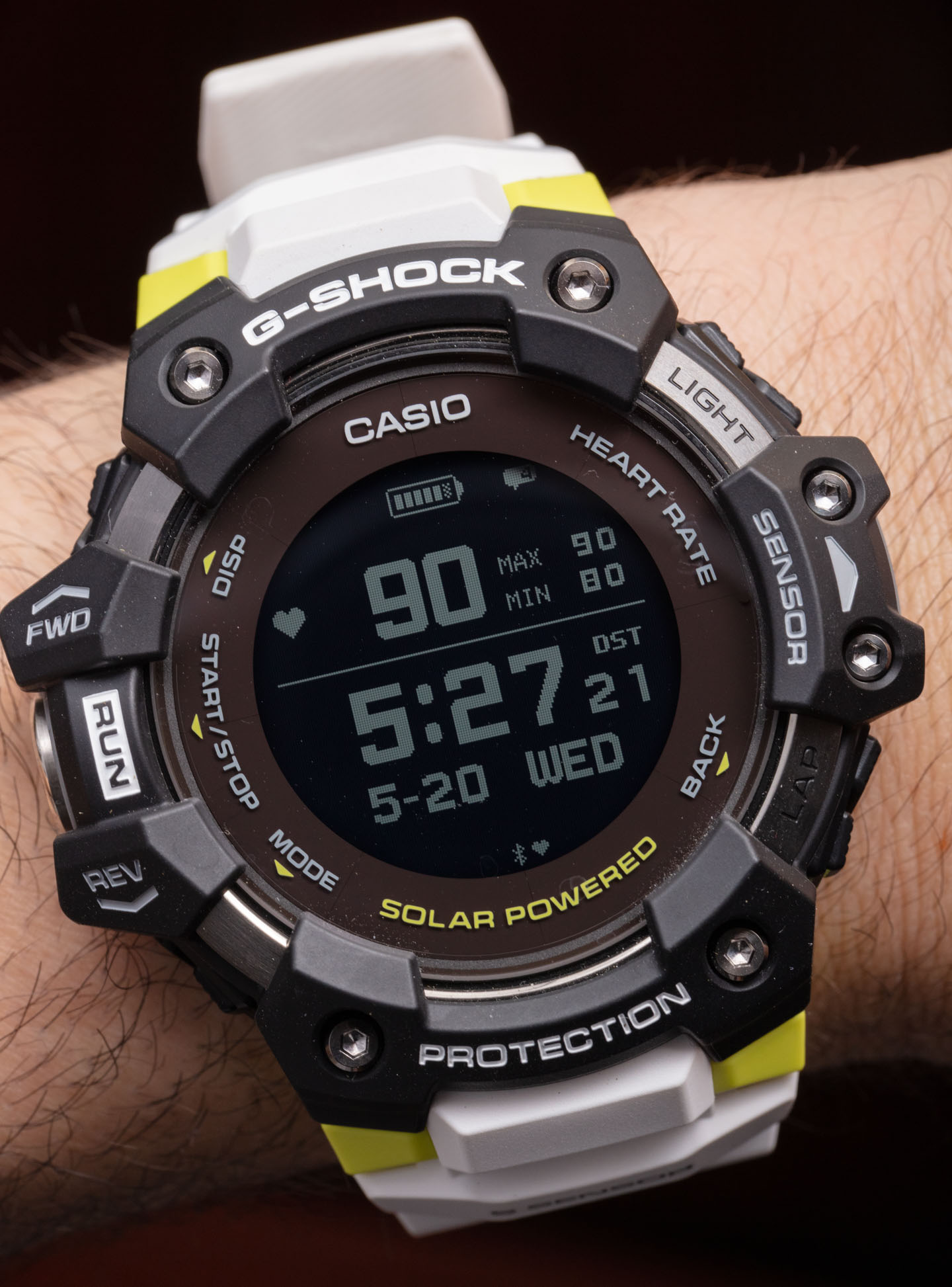
Unlike some other activity tracker watches, Casio does not seem to allow you to indicate what sport or activity you are doing. Garmin and Apple both want the user to tell the device what activity they are doing (biking, swimming, running, etc…) prior to working out. Casio still needs you to manually tell the G-Shock Move when you are going to work out, but you just activate it without selecting a specific activity. I don’t know the full implications of this, but my guess is that this will lead to more simple operation for many consumers, but there might be precise data points that the GBD-H1000 doesn’t track as well as other smartwatches.
As a GPS-based device trying to be lean on power consumption I found that the activity tracking of my hikes was pretty accurate. Though I did find that in some areas the GBD-H1000’s readings varied from those of a Garmin MARQ. I already tested the Garmin MARQ and the Apple Watch during exercising tracking and found that the two devices were remarkably similar in their results. Casio seemed a bit off when it comes to heart-rate tracking, altitude, and calories burned. That said, if you use the G-Shock Move all the time, it will track consistently, so even if you are burning more calories than the watch says you are, you know from work out to work out how your performance is trending.
My guess is that Garmin and Apple are allowing more power for GPS and other tracking functions while Casio is being decidedly more lean about it. That probably has some minor performance implications and that explains the different readings. I don’t really see this as a ding on Casio but more generally want to tell consumers not to expect all activity trackers to track the same, even if they all say they track the same metrics.
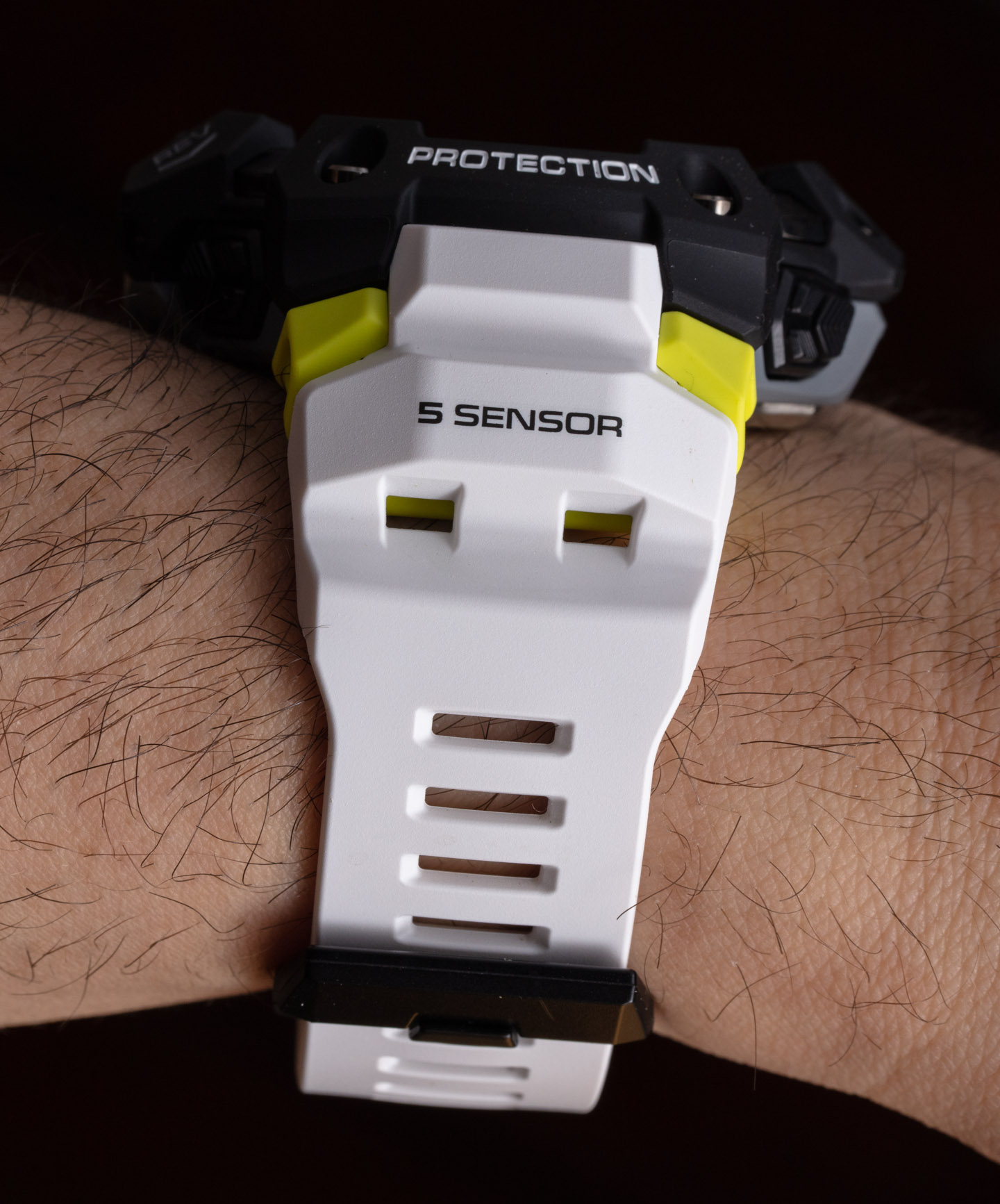
While currently tracking a workout, you have access to a few screen displays. I like being able to view my current heart rate as well as things such as the total distance or time I’ve been exercising. Most of this can be accessible, but I still found myself scrolling through screens a bit more than I’d like while trying to focus on hiking. That is a common complaint about most activity trackers, though. What I’d like to see in the future is software in the G-Shock Move app that lets me create custom viewing experiences so that when I am working out I can see just the data I want in front of me without having to fiddle with pushers too much.
Even if you are not actively measuring a timed workout or adventure, the GBD-H1000 can still tell you things such as your current heart rate and a slew of other data. It just won’t be using GPS for tracking, etc… So even as a casual sport watch with added tools such as a compass, HR monitor, and step counter, the GBD-H1000 can work really well.
Finally, let me discuss the “Workouts” mode which is actually somewhat different from activity tracking (which most people will refer to as the watch tracking their current workout). Workouts on the watch is one of the main mode screens and, in essence, is a series of up to five “stackable” and programmable repeating countdown timers. This is best used for people who like to incorporate interval training into their exercise regimes. It is popular, for instance, to do workout sessions that rely on a series of three-minute countdown intervals. The watch can be programmed for that. You can also get more complicated with it and program five instances of a three-minute countdown timer, followed by three instances of a 10-minute countdown timer. While some planning is required, this novel feature finally offers a satisfying solution for those seeking interval training functionality on their watches.
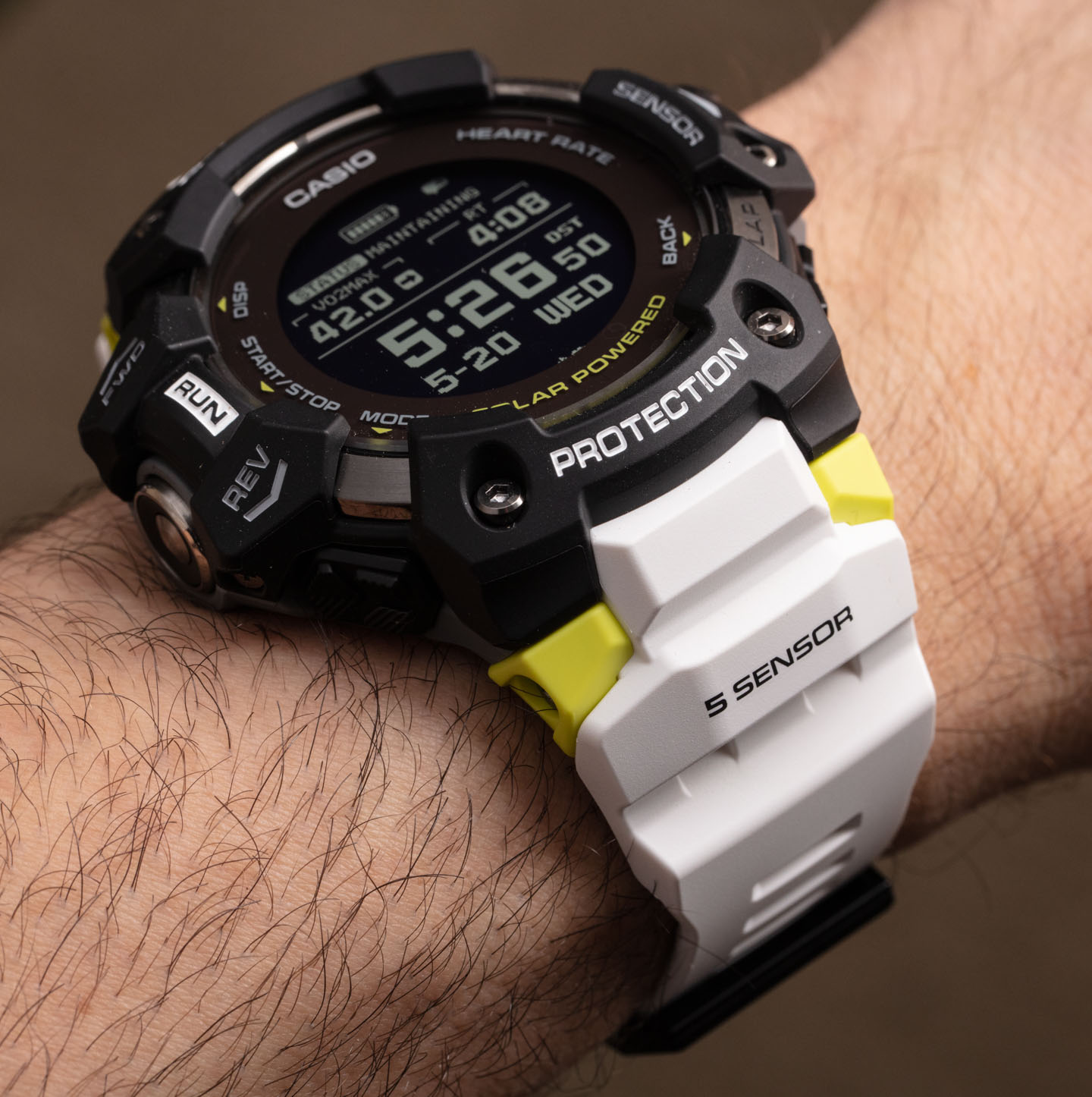
Consumers G-Shock Move Watches Are Best For
Most consumers today still don’t really have experience incorporating a smartwatch into their exercise or lifestyle regimen. That means they rely on the products to tell them what to expect as opposed to buying new smartwatches and activity trackers with too many built-in expectations. Not having to recharge them too often may be among the few exceptions to what I just said.
This implies that just as consumers will tell Casio how to evolve its hybrid smartwatch next, Casio is telling consumers how to make use of these products. I encourage avid adventurers and regular exercisers to experiment with great products like the G-Shock Move GDB-H1000 and see how they can help improve their lives and fitness goals. For many people, the mere ability to see the distance they have traveled, the time it took them, and the effort necessary are useful enough.
Casio has even more advanced athletes in mind with the GBD-H1000, offering features such a VO2 max calculations and recommended recovery times. These tools are useful, but unless you already come to the plate knowing how to use these features, the GBD-H1000 device itself won’t give you too many hints. This is a larger issue with fitness trackers that I think will resolve itself in the coming years as consumers have more built-in knowledge of how to use these devices in a more complete fashion.
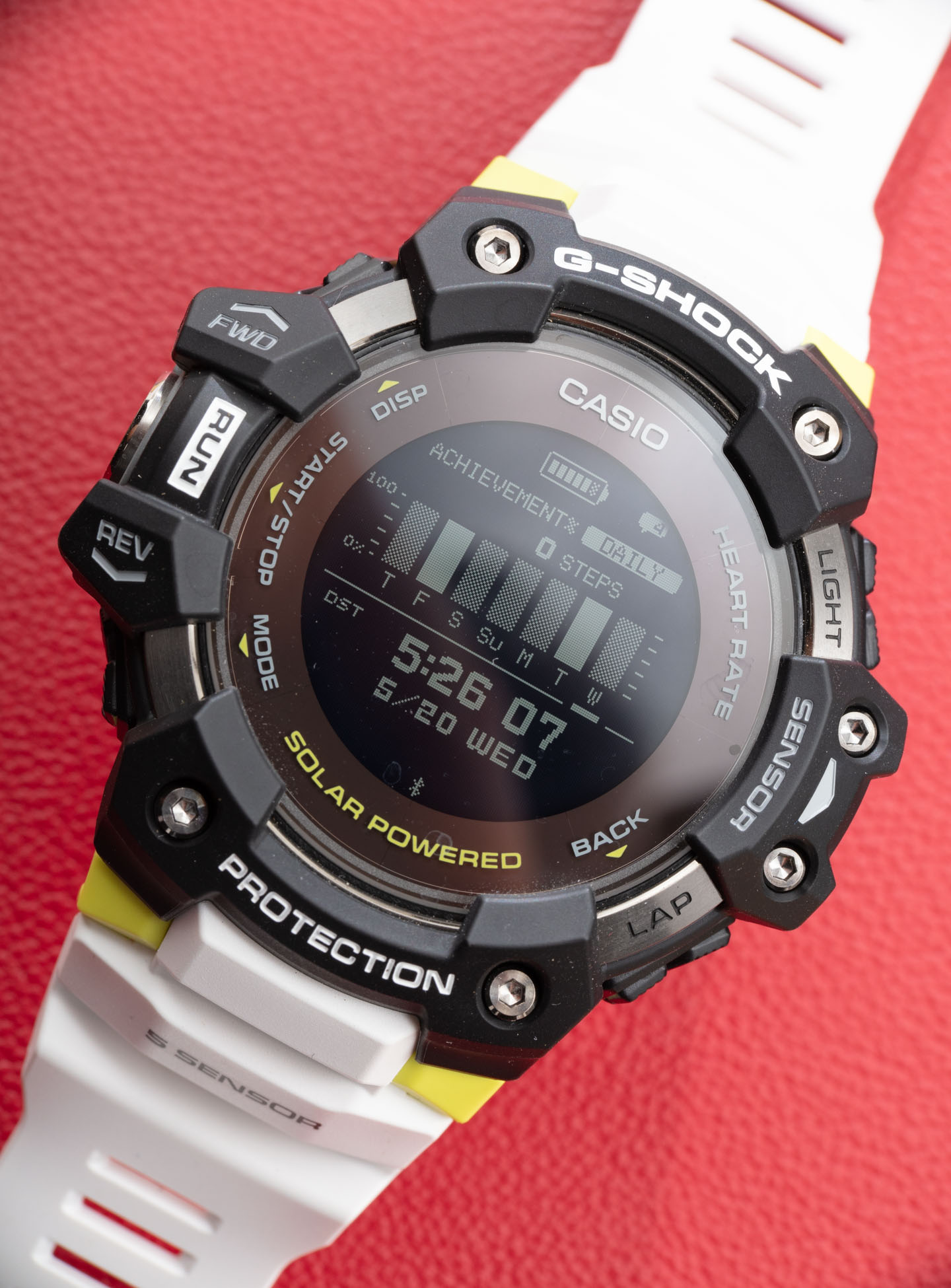
If you never want to track a workout, is the G-Shock Move a good timepiece for you? That’s a good question. Like I said, the watch is designed to offer a seamless, autonomous wearing experience that doesn’t require a smartphone and doesn’t require charging if you leave the GPS feature off. New tools such as the heart-rate monitor are useful throughout your day, such as a means to measure stress or to make sure you are putting in enough cardiovascular effort when you are seeking to do so. The GBD-H1000 represents Casio’s latest move to develop a new operating system, which is still just a few years old. More time will have to pass before lay consumers see this in more fashion-forward or slimmed down G-Shock models with accordingly refined and focused feature sets. This is important to mention because lovers of smartwatches and similar timepieces are naturally segmented between openminded early adopters with a willingness to experiment and impatient consumers seeking the latest tech experience on their wrist.
Casio’s G-Shock Move GBD-H1000 currently leads the activity-tracking watch industry in a few areas, namely when it comes to its own special blend of mixing battery life with lots of functionality. I never feel like the GBD-H1000 is simple in its features, even if the core functionality of the watch is more streamlined than some of the competition that offers a truer smartwatch experience. Most importantly, the GBD-H1000 is a novel-feeling device that will still make traditional G-Shock product enthusiasts happy. Casio continues to prove that it would rather keep quality, performance, and expectations high, even if it debuts new features a bit more slowly than some of the technology competitors out there. I’m certainly going to be keeping this watch on my wrist while being active for a long time to come. Price for the Casio G-Shock Move GBDH1000-1A7 is $399.99 USD. Learn more at the G-Shock website here.
Necessary Data
>Brand: Casio
>Model: G-Shock Move GBD-H1000 (reference GBD-H1000-1A7 as tested)
>Price: $399.99 USD
>Size: 55mm-wide, 20.4mm-thick, and 63mm lug-to-lug distance
>When reviewer would personally wear it: As daily wear sports watch when features such as a compass and heart-rate monitor are useful, or as a dedicated activity tracker when I will likely be away from a charging station for a few days.
>Friend we’d recommend it to first: Anyone interested in enjoying a next-generation G-Shock product that they can now fully incorporate into a trackable, active lifestyle.
>Best characteristic of watch: Excellent battery life as compared to the competition. Highly legible and crisp screen. Loads of performance/features for an activity tracker that is more traditional watch than it is smartwatch.
>Worst characteristic of watch: Color scheme isn’t for everyone. Case is still quite large despite being comfortable on the wrist. Understanding how to use the new operating system requires a learning curve. System slow on watch when saving/deleting data.

